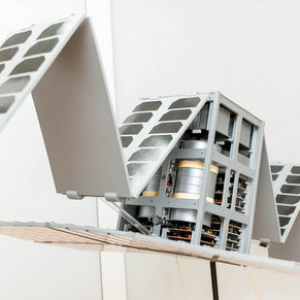Samara University’s scientists and students will conduct in outer space the experiment, results of which will show how much nanosatellites are polluted during operation in orbit. For detecting the contamination degree, scientific equipment with very precise quartz microscales will be used for weighing the smallest particles of special ‘dust’ to form in outer space around satellites, spacecrafts, and orbital stations.
The experiment will take place on board of the Russian radar nanosatellite AIST-ST, jointly designed by Samara University’s scientists and specialists of the company “Special Technology Centre” (STC) from St. Petersburg. The satellite launch is scheduled for the second half of 2024, and the spacecraft is currently being assembled. In future, the data obtained during the orbital study will help to improve quality of the optical and radar equipment of the Earth remote sensing satellites.
“On the AIST-ST spacecraft, among its payload, the special measuring unit designed by our University’s students and young scientists will be installed. During the flight, this unit will measure the degree of contamination of the outer surface of the nanosatellite body due to the effects of the so-called own outer atmosphere, which is formed in outer space around the spacecraft. Similar experiments and research have been conducted before, but on larger facilities, for example, on large satellites and on the International Space Station. Our experiment will take place for the first time on board of a nanosatellite. In May 2024, this development obtained the invention patent from the Federal Service for Intellectual Property (Rospatent),” said Maksim Ivanushkin, Head of Samara University’s Cyber-Physical Factory of Small Spacecrafts.
The own outer atmosphere (OOA), which forms in microgravity conditions around spacecrafts — satellites, spaceships, and orbital stations, — is a small cloud that may consist of molecules of various liquids and gases, as well as microscopic solid particles, for example, peeling off from the outer coating of the hull. The processes of microcorrosion and degassing of the hull materials, evaporation of possible condensate from the outer surface of the device, gas separation from leaky compartments, operation of on-board systems, and other reasons are ‘to blame’ for the cloud to emerge.
The own outer atmosphere gradually contaminates the spacecrafts. The satellite optics primarily suffers from such contamination, and image clarity deteriorates. Moreover, molecules of liquids and gases in the spacecraft’s own outer atmosphere tend to ionize, which results in distorting the amplitude and the phase of radio signals, leading to deterioration in the accuracy of radio measurements and failures in receiving signals from the Earth.
Researching the influence of their own outer atmosphere on spacecrafts began even in the USSR, in the early 80s of the last century, at the Salyut-7 orbital station. The research principle has not changed since then; only dimensions and the component base of the scientific equipment have changed. Contamination is measured using particularly accurate quartz microscales: one ‘cup’ of the scales, i.e. one quartz resonator, is located inside the spacecraft and is a reference one isolated from the external environment. The other resonator, i.e. another ‘cup’ of the scales, is exposed to the outside, into outer space, and is contaminated by the own outer atmosphere of the spacecraft. As the result, the mass of this second resonator gradually increases due to microscopic ‘dirt’, and its operating frequency changes. The difference with the frequency of the reference resonator makes it possible to determine the spacecraft contamination degree, and the data are periodically transmitted to the Earth.
“Our module is built on the basis of quartz microscales, that is, there are two quartz resonators directly in the body of the unit itself, one of which is hermetically sealed with protective glass, it is the ‘witness quartz’. Another quartz will ‘look out’ into outer space, being flush with the surface of the nanosatellite body. This research is very important for assessing the effect of the spacecraft’s own outer atmosphere on highly sensitive on-board equipment, for example, stellar sensors or optical instruments for the Earth remote sensing. Since we know what materials are used for manufacturing the spacecraft, we can draw conclusions about parameters of a particular material in orbit, based on the contamination degree and rate. The data from such experiments help designers of space technology to choose less ‘dirt-forming’ materials, which allows them to maintain high-quality specifications of on-board equipment in outer space. During the upcoming on-board experiment AIST-ST, we will be primarily interested in changing parameters of various types of plastic in outer space,” noted Maksim Ivanushkin.
Despite the seemingly microscopic size of the particles and molecules of the own outer atmosphere, results of previous experiments on researching the OOA show that large spacecrafts can become very significantly contaminated. According to open sources, during operation, the hull of a large satellite weighing over 3 metric tons emits up to 1 kg of various substances into the near-satellite space; however, about 100 g of these substances are deposited on the outer surface of the hull in the form of polluting films (“Vestnik of Samara State Aerospace University”, No. 2, 2009, p. 24).
About the Satellite
Being designed jointly by Samara University’s scientists and specialists of the company “Special Technology Centre” (STC) from St. Petersburg, the AIST-ST nanosatellite should become the first domestic nanosatellite with the radar unit: before that, in Russia, radars were installed on larger spacecrafts. Currently, the satellite is being assembled, and its engineering model is being tested. The device launch is scheduled for the second half of 2024.
Works on creation of the AIST-ST satellite are implemented within the Priority 2030 Federal Strategic Academic Leadership Program. In future, the satellite design is planned to be adapted for robotic assembly at the pilot production of Samara University’s Cyber-Physical Factory of Small Spacecrafts in the framework of the Advanced Engineering Schools Federal Project.
 RU
RU  EN
EN  CN
CN  ES
ES 